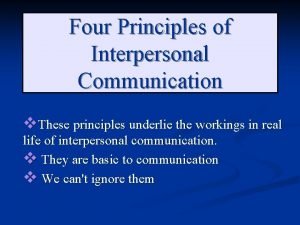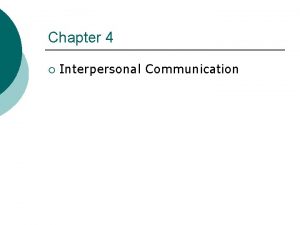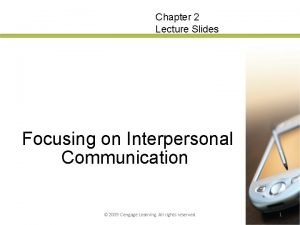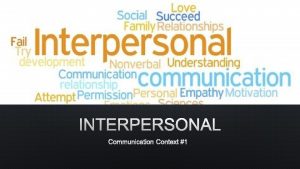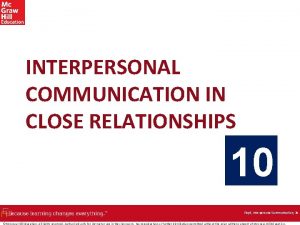Chapter 9 Relationship Development n Interpersonal Relationships Relationships















- Slides: 15

Chapter 9 Relationship Development

n Interpersonal Relationships: Relationships between two individuals that can range from mere acquaintance to meaningful friendships that last over a period of years. n n Interpersonal communication begins with predictions. (Think of two people in that range of interpersonal relationships. For example, an acquaintance and a meaningful friendship. How does each relationship differ? )

Levels of Information n I. ) Cultural Level n n A. ) Geographic differences B. ) Gender norms II. ) Sociological or Group Level n A. ) Stereotyping III. ) Individual Level

Cultural Level Information n Cultural level information about a person, you know the general characteristics that person shares with a large number of people like him or her. Cultures share: 1. ) geographic area 2. ) common language habits 3. ) beliefs 4. ) values 5. ) rules 6. ) norms (procedures) QUESTION: What are some beliefs, values, rules, or norms that you have in your family?

Cultural Level n Cultural Level Information *Americans n n n rich and generous baseball and football friendly *Women like fashion *Men don’t like cooking Are the above statements fair descriptions of Americans? Of women? Of Men?

Geographic Differences n n n People from different cultures would have to understand the others’ cultural beliefs for meaningful communication to take place. Information about norms and values held by people within a culture is important if you are to be involved in cross-cultural communication. Once you know the rules for appropriate interaction for people in a given culture, you can adapt your verbal and nonverbal messages to be most effective.

Examples of Geographic Differences n n n Traditional Japanese communication behaviors include bowing to others in greeting and refraining from interrupting a speaker for any reason Many Asian countries, religious beliefs hold that a person is reincarnated, or returns after death in a new form. Life and death are looked upon differently than in Western cultures. In some Arab countries, native woman are expected to appear in public places only when wearing a heavy veil (Burka) over their faces, so no men, except their husbands, can see what they look like. How would you characterize Americans? How does your picture of Americans affect your communication? What communication rules do you assume other Americans follow?

Gender Norms n What would you think if you observed the following scenes? n n When two men greet each other on the street, they kiss each other on both cheeks? When attending classes, only males are allowed to speak.

Gender Norms cont… n n n People in other parts of the world are becoming more aware of different cultural behaviors through television and international travel. Beliefs about gender may lead to stereotyping What are some stereotypes or gender norms we associate with the opposite sex?

Gender Norms n What rules did you learn while growing up about talking to other people? (Exp. To Adults, elderly, young children, males, females) Overview on cultural information: 1. Provides you with general information 2. Helps avoid breakdown in communication 3. Not enough information to make accurate predictions 4. Limits effectiveness of communication 5. At this level predictions are still based on information that is characteristic for masses of people.

Sociological or Group Level n n n Gives you information about a person’s membership in a group. Joined a group because of same characteristics of other group members (“membership” or “joining” a group are different) Common characteristics can help Make predictions about how he or she will respond to certain messages Do you belong to any groups?

Sociological or Group Level Predictions about groups: For example, You know a person is a teenager, you might assume he or she is interested in skateboarding, dating, current movies, and school activities. OR If you know a person is an archeology student, you might assume he or she is interested in ancient cultures, knows several languages, and is adventuresome n Be aware that not all members of a group are the same.

Stereotyping n n Predictions about other people based on characteristics of the large group (culture) or smaller groups (sociological) to which they belong. Labeling people as being part of a certain group and treating them as if they only possessed all the characteristics of that group is called STEREOTYPING! FOR EXAMPLE: labeling someone a “jock”, or “lazy” Stereotyping means you are using your lowest level of perception ability.

Individual Level n n n 3 rd level of information Individual level: you have learned the special or unique characteristics of a person. Past experiences + the person’s values, beliefs, and attitudes=knowing the individual At this level you know he or she is different from all the other people in the many groups to which he or she belongs. Rules that guide interaction between you and another person are created by the two of you, rather than being set by society, you are using individual information. Pay close attention to his or her behavior to discover what makes that person different from all the others, or unique

Individual Level n n The more information you have about a person, the better you will be able to predict his or her behavior, including attitudes, values, and rules for interaction. You can send verbal and nonverbal messages created exactly for that particular person.
 Characteristics of interpersonal
Characteristics of interpersonal Communication is inescapable
Communication is inescapable Interpersonal relationship stages
Interpersonal relationship stages Define interpersonal communication
Define interpersonal communication Interpersonal skills
Interpersonal skills Interpersonal relationship theory
Interpersonal relationship theory Relationship management vs relationship marketing
Relationship management vs relationship marketing Chapter 6 interpersonal communication
Chapter 6 interpersonal communication Chapter 10 interpersonal skills
Chapter 10 interpersonal skills Chapter 5 interpersonal communication
Chapter 5 interpersonal communication Chapter 3 interpersonal communication
Chapter 3 interpersonal communication Communication process noise
Communication process noise Chapter 10 interpersonal skills
Chapter 10 interpersonal skills Interpersonal communication vocabulary
Interpersonal communication vocabulary Chapter 8 interpersonal communication
Chapter 8 interpersonal communication Interpersonal communication chapter 2
Interpersonal communication chapter 2

